Stahlbush’s New Biodegradable Frozen Fruits and Vegetables Bag is Plastic.
One thing I learned to my dismay back in 2007 when I decided to try and live without plastic is that without exception, all frozen foods come packaged in some kind of plastic. Even cardboard containers like ice cream cartons are lined with plastic. That information sucked for me, the convenience food junkie.
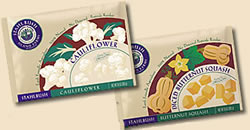 I did however, have a moment of hope when I discovered Stahlbush Island Farms’s frozen fruits and veggies packaged in what looked like plain brown paper. But that hope was crushed when I opened the bag and saw that it too was lined inside with plastic.
I did however, have a moment of hope when I discovered Stahlbush Island Farms’s frozen fruits and veggies packaged in what looked like plain brown paper. But that hope was crushed when I opened the bag and saw that it too was lined inside with plastic.
Well, recently, several readers have excitedly informed me that Stahlbush’s packaging is now labeled as biodegradable.
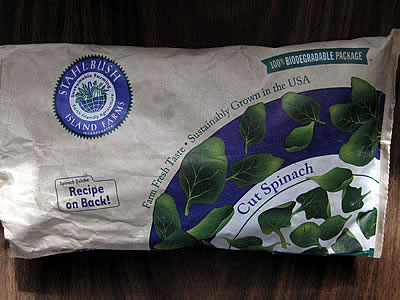
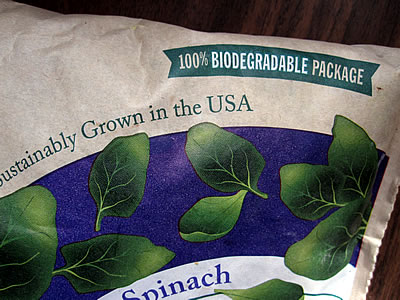
So I went out and bought a bag of frozen spinach just so I could look inside. Here’s what I found:
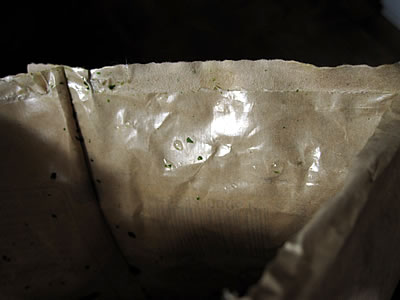
Looks like plastic, right? The Stahlbush web site doesn’t give any details about the new bag except to say it’s biodegradable. So, not one to accept any company’s claims without question (and always skeptical of the word “biodegradable” in the first place), I made some calls to get to the bottom of the packaging mystery.
Stahlbush sent me their press release (PDF) about the new biodegradable bag. But it only mentions the brown kraft paper and biodegradable inks. The press release says nothing about the plastic lining.
So I spoke with Mike Serve of Cadillac Products, the manufacturer of Stahlbush’s bags. He told me that the lining of the bag is in fact petroleum-based plastic. The difference is that it contains an additive which causes the plastic to break down in a matter of months. What’s the additive? “Ah, that’s our secret ingredient!” he told me.
And that about sums up the plastics industry. As a rep from Stonyfield Farms told me back when I reviewed that company’s new compostable plastic containers, “Plastic is the most secret industry you can imagine.”
So, that’s the scoop, folks. The package is made with a petroleum-based plastic lining. The plastic contains chemicals which the manufacturer is not willing to reveal. Same old story, except that this package will supposedly biodegrade. But where are the tests proving that it breaks down sufficiently? How do we know it doesn’t leave traces of plastic or toxic additives in the environment? And how do we know that chemicals from the plastic cannot leach out into our food?
We don’t.








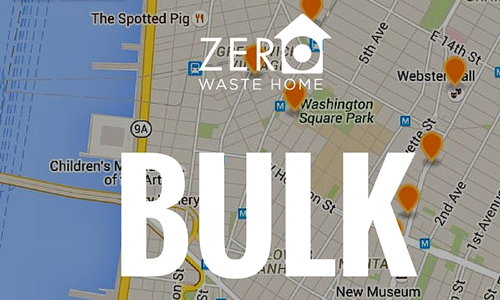


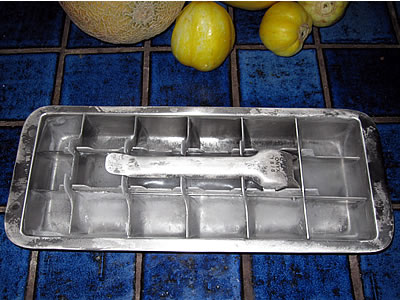

Hi, can anyone tell me, please, are tetra packs considered as eco-friendly? A better alternative to plastic?
Thanks for doing the research for us. I saw these on Instagram stories a few weeks ago. Was super excited but I’m glad I dig deeper to discover your post.
Just wanted to comment that I have attempted to compost a few Stahlbush vegetables bags in my backyard compost bin, with no success. One bag was in there for over a year when I finally gave up and removed the entirely unscathed bag to the garbage bin. Apparently ‘biodegradable’ is not to be confused with ‘will decompose into something natural and usable within a reasonable period of time’, as Miriam mentioned below.
Biodegradable and compostable are most definitely not interchangable, no matter how often the media or companies do it. Lots of things biodegrade, sometimes even plastics made of oil, but it is really a greenwash claim in the realm of packaging.
Good to see someone is making the companies accountable for their advertising. Did you ever find out more about this?
I think the problem with bio-degrade plastics is they take forever to degrade in landfill and the like. What most people don’t realize is so does a lot of other stuff even things like banana skins.
In response to my follow-up inquiry (in which I cited this blog), I received the following from the national retail sales manager at Stahlbush (contact info at the end). Anyone want to translate?
The FDA compliant additive the we utilize is less then 2% of the entire lamination and does not pose a toxic threat to the product or the environment.
At the end of the laminations degradation cycle it returns to the environment not as small particles, but as biomass and humus.
The lamination does not contain heavy metals unlike most oxodegradeble products.
Our additive supplier has engaged several renowned testing laboratories to independently establish the biodegradability of plastic products using the bio supplier’s additives. The tests concluded that the products were fully biodegradable under both aerobic and anaerobic conditions. In addition, the tests concluded that their biodegradation did not produce any toxic residue harmful to living organisms in land or water.
Our additive supplier certifies to us the that products using the additive have been tested and proved as biodegradable and safe for the environment by using the following:
. ASTM D5209 “Standard Test Method for Determining”
the Aerobic Biodegradation of Plastic Materials in the
Presence of Municipal Sewage Sludge”;
. ISO 14855 / ASTM D5338 “Standard Test Method for
Determining Aerobic Biodegradation of Plastic Materials
under Controlled Composting Conditions”; and
. ASTM 5511 “Standard Test Method for Determining
Anaerobic Biodegradation of Plastic Materials Under
High-Solids Anaerobic Digestion Conditions”.
An explanation of the technology:
The plastic products made with the biodegradable additive will break down in approximately 9 month to 5 years in nearly all landfills or wherever else they may end up. All sorts of factors determine the amount of microbes available in the soil and the soil conditions determine the rate of degradation. The plastic products made with the additives technology basically rely on the microbes in the soil to react with the additives and form communities, biofilms, which create the enzymes and acids that can attack the longchain hydrocarbon molecules and break them down to the point that the microbes’ natural acids and enzymes are then effective and the microbes can metabolize the simple hydrocarbons with CO2 and water or methane being the waste products. This process continues until all the plastic product is full biodegraded.
Daniel Stockton
National Retail Sales Manager
Stahlbush Island Farms
Farmers Market Foods
(541) 757-1497 Office
(541) 760-0358 Cell
(541) 754-1847 Fax
dan@stahlbush.com
http://www.stahlbush.com
Ugh! This is so discouraging. I’ve just started my own non-plastic journey and was keeping this brand in mind for quick veggies for our toddler. Luckily our local co-op just started carrying some bulk frozen veggies. Thanks so much for all your research, I’ve learned a ton from your site.
Jen
In an environmental forum I belong to, someone mentioned Dole was supposed to start using biodegradable packaging to help with our environment.
grant for school
Thanks for doing this research and for posting. I’m glad to know! Disappointed, but glad to know anyway. Peace! :)
“petroleum-based plastic lining” – it might be biodegradable but is it environmentally friendly?
What about frozen spinach. Isn’t that just frozen in waxed paper boxes? I’ve never seen any plastic inside those.
How careless they are! Atleast, they need to prove that their product is really degredable and noway harmful to our pretty environment.
Thanks for making us aware.
Keep posting.
Hi JoAnn. I hear you! I know a lot of businesses are out there trying to find good alternatives. BUT what really irks me the most is the secrecy of the plastics industry. I understand that companies don’t want to give away their trade secrets, but as a consumer, without knowing what chemicals have been added to the plastic packaging, I have no way of knowing what could leach out of it. And that really worries me.
It’s true that frozen foods necessitate plastic right now and that during the winter many people have to rely on them. But I write articles like this because I think consumers have to be fully informed. Otherwise, they see a word like Biodegradable and think it’s automatically a healthy, no impact product. I want them to think critically.
Hi Beth:
As I promised in Twitter.
The whole sustainable plastics packaging issue is murky in the eyes of consumers. Everyone wants a better environmental packaging solution including the packaging companies.
There are a variety of solutions that have been developed to address the issue some more successful than others. Its a very complicated problem one that will take some time to resolve.
Just look at what happened with the Sunchips attempt to create a compostable (biodegradable) package. Consumers went over the edge complaining that it was too loud and noisy. So much so that they ended up taking it off the shelf due to loss of market share. I researched the entire saga extensively for my presentation at the Sustainable Packaging conference. Consumers on one hand said they wanted the “eco” packaging and on the other hand rejected a viable solution outright.
I applaud efforts to use less packaging and to demand more sustainable solutions. But give the industry some credit. We can’t get there overnight and at the present the packaging technology just hasn’t been developed to replace plastics. There is significant research and money being devoted to solve the problem but for the time being if you want frozen food plastic is the only solution.
While I love reading blogs about people attempting to reduce their impact with consumer plastics, I very rarely comment on my opinions. I think that blogs often attract people of a similar mindset and I’m a bit of a plastics nut (I’m working on a master’s of science in plastics engineering with specialization in Medical Plastics and interest in sustainable feedstock plastics).
I admit that plastics are often used in wasteful ways, there are often factors which make plastics the best choice for specific applications. The journey of frozen food packaging requires specific packaging, handling, shipping and storage before it ever gets to the customer’s home. These requirements severely limit what kinds of materials can be used to keep your veggies fresh and contained in a durable fashion.
The use of biodegradable on packaging is difficult for me. Biodegradable gets thrown around in so many different cases, it tells you nothing about the origin of the feedstock, the mechanism of degradation, the required environment for degradation to occur, the expected degradation rate or the standards to which the degradation rate was tested. Many Americans do not have access to appropriate environments for biodegradation to occur. A material may be compostable in a matter of months (Sunchips bag) or degrade in landfill conditions over the course of decades (Brooks midsoles)
It is also important to understand that not all bioplastics (plastics based from plant feedstock) are biodegradable and not all biodegradable plastics are bioplastics. Most people associate biodegradable with organic materials such as an apple cores that will degrade our everyday environment. This makes it an ideal buzzword for greenwashing marketing. It’s a simple idea.
Something that concerns me about this packaging is the method of degradation. Some degradable materials use heavy metals as catalysts to perform plastic chain scission. I wouldn’t want that in contact with my food. Although I’m sure companies consider this in their safety evaluations.
In my opinion, the best bet for a plastics conscious individual who wants the luxury of frozen vegetables is to purchase the largest bag of vegetables possible.
It’s all greenwashing. I have been working in Marketing for several years and anything any company writes is all lies. Free always means Costs Money. Save always means Spend. And Green always means Pollutes. There is no convenient way to do a plastic-free life. The only way to do it is to buy direct from the farmer or grow your own. Anything you buy in a store, even if it sits on the shelf without plastic wrapping, was wrapped in plastic at some point in the supply chain. Even the farmers’ fields are wrapped in plastic these days. I’ve seen it.
I’ve heard of the cornstarch infused plastic, which is probably what this is. there’s a brand of “biodegradable” zipper bags made of this, I want to say it’s called “green head” but I can never find it when I look up that name. I have the link somewhere, if it matters. I also heard that some of the plastic rings on 6-packs of soda cans are made of this plastic, but I don’t know how true it is. I, too, wonder if this breaks down into smaller plastic pieces or whether all the polymer chains are broken down. I’d love to see the lab reports for things like this, if I could decipher them that is!
I use g diapers for my baby girl and they really do decompose in thirty days. I buried the wet ones as they advise and when I turned the soil over in thirty days they were pretty much decomposed. The actual diaper is plastic free, the reusable pant part is plastic. It is so hard avoiding plastic. I used to buy ice tea but now make solar in a big glass jar and it really works and no sugar. g
Am I crazy or did cut potatoes used to come in a paper bag only? I swear I remember that. Oh well, those bags probably didn’t keep the potatoes fresh for 20 years. lol
Thank you for exposing yet another misleading green scam. Much as I hate to shop there, the only place I can buy any vegetables, fresh or frozen, not packaged in plastic, is WalMart. Sigh.
I recently scoured the shelves at my local co-op to find chips, crackers — ANY snacks not in plastic and it was hopeless! Fortunately, homemade crackers are easy, but I guess I’ll never chip snack again. Speaking of homemade, I tried your mustard recipe last weekend and LOVE it! Now, I just ran out of ketchup – any progress on the condiment front? (I know it’s been a busy, tough year)
You can now get a type of ‘plastic’ which is biodegradable in just few months because it’s made (I think) from corn starch. I would guess that it is more expensive which is why you don’t see it very often, but rising oil prices could start to change that…
Life without plastic is very difficult. I admire you for setting this objective. Have you considered growing and freezing your own frozen foods and vegetables? You could package them in your choice of eco-friendly packaging.
In the Netherlands, my home country, we have a tv show, (Keuringsdienst van Waarde) which researches similar things. Not so long ago, they had a look at biodegradable and compostable packagings. There were three conclusions that made me quite sad actually:
1. Biodegradable is a hollow phrase, EVERYTHING is biodegradable. Only some stuff will dissappear after 1 month, and other stuff after 10,000’s of years. In theory, everything will degrade, eventually.
2. Compostable products are not processed in a commercial composter, since it takes too long to turn into compost. The product is being filtered out of the other compostable stuff, and burned with the regular trash.
And what shocked me the most:
3. Most of the compostable packagings is made by GENETICALLY MODIFIED corn, resulting in excessive use of pesticides, the destructive Monsanto way of life and so on, and so on.
It makes it really hard to find alternatives, when even the alternatives are fooling us! I guess NO packaging is still the best way to strive for….
Where I live we have a comercial composter and they WILL NOT take plastics that are labelled biodegradable, they must be labelled compostable. Most biodegradable products contain petroleum and most just break down into ever smaller pieces of…..plastic. It will still end up in our oceans and elsewhere and will never turn into a natural product. However, if a product trully is compostable (and of course there is no guarantee, even if they use the term)…then it will, with the right combination of heat and air, break down and become organic material (ie, soil). If a compostable or biodegradable product is put in the landfill – nothing will happen. It will remain the same for hundreds of years as landfills are designed to keep air and sunlight out and thus, the items don’t have the conditions to break down at all.
Its sickening that we are being “green-washed” like crazy with organic products in plastic and biodegradable (supposedly) packaging….how long does it take to biodegrade….possibly 10 years…..and possibly harming the environment in the process.
Sounds just like the Sun Chips bags that were not actually compostable in backyard composts. It’s really sad when companies tout such great “green” features that turn out to be false. This is why I no longer buy foods in packages when I can avoid it. Thanks for sharing this!
what about the chips bags from sun chips that state they are %100 compostable? i wonder if these are also some sort of plastic after all, in which case i should not buy anymore
Hi Elie. Someone else also asked that question. See my response in comments above. :-) Or read this post:
/2010/10/sunchips-discontinues-compostable-bag-do-we-care/
I just read your post about the compost sun chips bag. They are still available in Canada and it is the only “chips” we buy since starting this experiment. We use them to hold all our compost before it goes in the bin. I don’t think their sales have decreased in Canada because of the sound…I am pretty sure that the might have wentbup since th hype in the U.S.
Hi Melissa. The Sunchips bag was different. It was a plastic made from corn. Here’s what I wrote about that bag:
/2010/10/sunchips-discontinues-compostable-bag-do-we-care/
I don’t know anything about Puffins, and I didn’t realize Klean Kanteens came in a plastic bag. I bought mine off the store shelf unwrapped. I wonder if it was delivered to the store in a plastic bag. I’ll have to find out.
probably just scatters all the molecules, like the dispersants they used in the gulf oil spill. we know petroleum is forever.
I’m curious about the “Dogs on Board” biodegradable poop bags. Is it the same problem because I’m spending extra money on these? Thanks for your great site. Very inspiring!
At least it’s a step in the right direction. A move towards less plastic is still something.
Though I too have stopped using frozen fruit… they used to be a staple for my morning smoothies. I’ve switched to home grown or our local CSA for most my fruit and veg needs.
Is the same true for the short-lived Sunchips & the Puffins bio cereal bag? What about the bag klean Kanteens come in?
what sneaky ….
So sad that they are doing this, they are misleading so many people. Guess it just shows that fresh is best!
Fonda LaShay
http://www.mintandchili.com
Thanks so much for persisting and following through on the plastic question. You make my resolve to stock up and freeze or dry fruit (to be stored in glass) this summer that much stronger!
Even though I haven’t posted pictures and plastic count, I continue to reduce my plastic waste. Your site is a huge help!
-Renee
Scary and sad!
If it’s any consolation, I bought a bag of their sweet potatoes (because their farm’s mission statement sounded so noble) and they were awful. Not just “not great” but just plain awful. Sounds like their customer service was pretty awful, too.